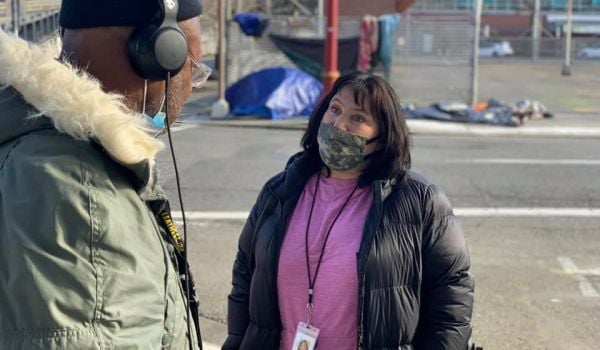Eric Adams’ Plan For Mentally Ill People Facing Homelessness Vs. Reality
In November, New York City Mayor Eric Adams announced new guidance for police and emergency medical services, directing them to take severely mentally ill people – often experiencing homelessness – off the street so they can be evaluated for psychiatric hospitalization. The state’s mental health law allows police to move people who appear to be a threat to themselves or others to hospitals or psychiatric care. Mayor Adams’ guidance interprets that law to mean police officers can detain people based on the suspicion that someone is a danger, “even when no recent dangerous act has been observed,” in line with a guidance published by the state’s mental health agency earlier this year. If someone appears unable to care for themselves, the mayor said, police and clinicians should be able to remove them for evaluation.
The guidance was criticized by nearly every entity that would have to carry it out, including the NYPD and EMS workers. The state has long had a shortage of psychiatric hospital beds, seeing a reduction in 20% from 2004 to 2014 as part of a national trend of cost-cutting, and the Adams administration has not done much to rectify this. One potentially helpful intervention – though by no means a panacea – would be a greater availability of supportive housing, which provides on-site social support for people experiencing mental health problems. The city has a shortage of this type of housing, yet 2,600 units are currently vacant citywide, according to the New York Times, a result of bureaucratic red tape. Mayor Adams vowed to address the problem in March but without hiring any additional staff to process the backlog resulting in about 100 more vacant units than 8 months ago.
In mid-November Mayor Adams announced a “Street To Housing” pilot meant to place people experiencing street homelessness directly into supportive housing. (Previously, the requirement was that people pass through the shelter system first.) But that pilot is starting small, with just 80 people compared to the over 3000 experiencing street homelessnes across the city, and it’s too early to say if it has found success.
Sacramento County and City Reach Measure O Deal
In November, voters in Sacramento weighed in on a ballot initiative that would ban camping on public and private property. That measure was certified on Wednesday, with 52% of people voting yes and 48% voting no, according to CapRadio.
The proposal included a requirement that Sacramento city and county reach an agreement to jointly execute the camping ban if voters approve it. That deal was approved on December 6. It requires the county to create 600 shelter beds and calls for combined city-county outreach teams, including newly-hired mental health and engagement staff. It also calls for additional measures, like exploring involuntary commitment of mentally ill people. The plan does not appear to address long-term housing.
There were 9,278 people experiencing homelessness in Sacramento according to a 2022 point-in-time count, a 67% increase since the last such count in 2019.
New Report Shows Uptick In New Jersey’s Investor-Owned Homes
A report from New Jersey’s Department of Community Affairs reveals a stark increase of investor ownership of single family homes in the state between 2012-2020. In 2020, one in 17 single-family to four-family homes were owned by institutional investors – meaning they were owned by entities such as LLCs or trusts, rather than individuals. The rise was most stark in Trenton, which saw 15% of its housing stock shift to investor ownership between 2012 and 2020.
These purchases were most often in shoreline communities, and happened more frequently in lower-income or distressed neighborhoods. The effect of these buying sprees was that home prices rose across the board. According to the report, a 1% increase in the share of homes owned by investors led to $7,891 sales price growth over five years.
The rise in corporate and private-equity home-buying has received new scrutiny in recent months. In 2021, institutional investors went on a buying spree not seen in two decades, according to a Washington Post analysis. In June, the U.S. House Committee on Financial Services’ Subcommittee on Oversight and Investigations held a hearing on private equity homeownership called “Where Have All The Houses Gone?” A bill introduced last week by Sen. Jeff Merkley called the End Hedge Fund Control of American Homes Act would create a $20,000 penalty per home for investors who own more than 100 homes, according to Truthout.
This article is part of Backyard, a newsletter exploring scalable solutions to make housing fairer, more affordable and more environmentally sustainable. Subscribe to our weekly Backyard newsletter.

Roshan Abraham is Next City's housing correspondent and a former Equitable Cities fellow. He is based in Queens. Follow him on Twitter at @roshantone.


















